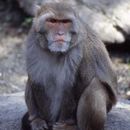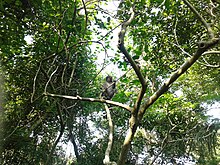en
names in breadcrumbs


Humans are reported to hunt these animals for their meat. They may also fall victim to raptors. However, Clouded leopards are the primary predators of these animals
Known Predators:
Formosan rock macaques are quadrupedal (Fleagle, 1988). They use cheek pouches to carry food in while foraging. The pelage is dark gray to brown in color. Tail length varies from 26 to 46 cm and body lengh ranges from 36 to 45 cm. They typically weigh 5 to 12 kg, though some adult males can be over 18 kg. The hairs are soft, a dark gray color in winter and an olive drab in summer; abdominal skin is slightly blue (Grzimek, 1988).
Range mass: 5 to 18 kg.
Range length: 36 to 45 cm.
Other Physical Features: endothermic ; homoiothermic; bilateral symmetry
Sexual Dimorphism: male larger
Most species in the genus Macaca live to be about 30 years old in captivity. Lifespans in the wild are probably shorter. It is reasonable to assume that M. cyclopis is like other members of the genus in this respect.
Formosan rock macaques inhabit primarily mixed coniferous-hardwood temperate forest, as well as bamboo and grassland at elevations between 100 and 3600 m . They are also found in coastal areas. (Grzimek, 1988)
Range elevation: 100 to 3600 m.
Habitat Regions: temperate ; terrestrial
Terrestrial Biomes: savanna or grassland ; forest
VOCAL COMMUNICATION:
Formosan rock macaques emit 'scream calls' when approached by a non-group members. Group members answer this call with a sound that sounds like "kyaw-kyaw".
VISUAL COMMUNICATION:
A fear grimace is when the lips are retracted so that the teeth are shown and clenched (Estes, 1991). This display functions as an appeasement signal to reduce aggression in aggressive encounters (Estes, 1991).
Staring with an open mouth but with the teeth covered indicates aggression (Estes, 1991).
As in other macaques, it is likely that tactile communication (grooming, playing, fighting, mating) is also important. There may be some chemical communication in the form a pheromones.
Communication Channels: visual ; tactile ; acoustic
Perception Channels: visual ; tactile ; acoustic ; chemical
Situated in a subtropical zone, Taiwan possesses a warm and moist climate and a large variety of plants and wild life. Of the world's approximately 4,500 species of mammals, Taiwan has 61. In order to protect these precious natural resources in the face of growing economic development the Taiwanese government has in recent years actively promoted concepts of, and measures for, environmental conservation which have become widely accepted by the general public. Taiwan actively participates in important international treaties and organizations such as the Convention on International Trade in Endangered Species (CITES) and the International Union for the Conservation of Nature (IUCN).
Macaca cyclopis once occured throughout Taiwan, but is now restricted to remote highlands by human encroachment. Macaques are killed for food, medicinal preparations, and taken as pets and for research purposes. The primary threat to their populations is habitat destruction.
US Federal List: no special status
CITES: appendix ii
IUCN Red List of Threatened Species: least concern
Parasites that infect M. cyclopis may be transmitted to humans, this is particularly a problem in recent years as tourism increases in the regions they inhabit and contact with humans becomes more frequent. They also are known to raid crops.
Negative Impacts: injures humans (carries human disease); crop pest
Macaques are popular zoo animals because of their active lifestyle and adaptability. They are also useful in biological, medicinal, and psychological research because of their similarity to humans in physiology and disease susceptibility. These animals may also be hunted for food.
Positive Impacts: food ; research and education
These animals may be important in local food webs, and in helping to disperse seeds.
Ecosystem Impact: disperses seeds
Formosan rock macaques consume a wide variety of foods, including fruits, leaves, berries, seeds, insects, animal prey, buds, young shoots, and small vertebrates. These macaques reportedly raid crops (Rowe, 1996).
Animal Foods: insects
Plant Foods: leaves; seeds, grains, and nuts; fruit
Primary Diet: omnivore
Formosan rock macaques (Macaca cyclopis) are found in the mountainous terrain of northeastern and southwestern Taiwan. They may once have been associated with the sea coast but have now been largely restricted to inland hills because of human activity (Kuntz and Myers, 1969).
Biogeographic Regions: oriental (Native )
Most macaques are polygynous. Given the sexual dimorphism in size seen in M. cyclopis, it is reasonable to assume that this species is, also.
Mating System: polygynous
Formosan rock macaques give birth to a single offspring per pregnancy. During estrus the perineum of the female swells at the base of the tail and along the thighs.
Gestation period is about 165 days. Young weigh an average of 400 g at birth. The mating season occurs from November through January, with births occuring from April through June. The mating season coincides with the peak of fruit availability. Females 5 to 9 years old usually give birth every other year, older females give birth every year (Rowe, 1996).
In most macaques, nursing lasts for about one year. Young are typically independent after about two years, although may retain life-long associations with their mother.
Breeding interval: Females 5 to 9 years old usually give birth every other year, older females give birth every year.
Breeding season: The mating season occurs from November through January.
Average number of offspring: 1.
Average gestation period: 165 days.
Average weaning age: 12 months.
Key Reproductive Features: iteroparous ; seasonal breeding ; gonochoric/gonochoristic/dioecious (sexes separate); sexual ; viviparous
Most parental care is provided by the mother. She grooms, nurses, protects her infant until it becomes independent. In most macaques, the period of nursing is about a year. Young are typically independent by two years of age. However, females may have relationships with their female kin for the remainder of their lives. Females remain in their natal group with the onset of maturity, but males disperse shortly before adolescence. There is a hierarchical dominance system among group members based upon the matriline.
Parental Investment: pre-fertilization (Provisioning, Protecting: Female); pre-hatching/birth (Provisioning: Female, Protecting: Female); pre-weaning/fledging (Provisioning: Female, Protecting: Female); pre-independence (Provisioning: Female, Protecting: Female); post-independence association with parents; extended period of juvenile learning; inherits maternal/paternal territory; maternal position in the dominance hierarchy affects status of young
The Formosan rock macaque (Macaca cyclopis), also known as the Formosan rock monkey or Taiwanese macaque, is a macaque endemic to the island of Taiwan, which has also been introduced to Japan. Besides humans, Formosan rock macaques are the only native primates living in Taiwan. The species was first described by Robert Swinhoe in 1862.
Rock macaques measure 50–60 cm and weigh 5–12 kg, generally females are smaller. Their tails are moderately long and measure 26–45 cm. The Formosan rock macaque is brown or gray in color. Like all other macaques, it has specialized pouch-like cheeks, allowing it to temporarily hoard its food. The gathered morsels are eaten sometime later, in safe surroundings.

Among the 22 species of the genus Macaca that are found in southern and eastern Asia as well as northwestern Africa, the Formosan macaque is the only species endemic to the island of Taiwan.
Formosan rock macaques live in mixed coniferous-hardwood temperate forest, as well as bamboo and grassland at 100-3600m (328-11,812 ft). The social structure of macaques is generally characterized as often occurring as a large stable multimale-multifemale troop.[3] Formosan macaque is considered to be female-bonded which is similar to other species in the genus Macaca. Based on the study of Hsu and Lin,[3] the average overall sex ratio was approximately 1:1, and the average adult sex ratio was close to 0.53. Solitary adult males accounted for 5% of the entire population, and they were seen interacting with social troops especially during mating season. They communicate using visual signals and sounds. They will "scream" when non-group members come near them. Group members usually respond using a "kyaw-kyaw" sound.
Rock macaques are diurnal, arboreal, and terrestrial. They usually stay in trees and less so on the ground. They rest in forest and forage in grasslands. Their diet consists of fruits, tender leaves, buds, grass stems, insects, snails, and bird eggs.
The Formosan rock macaque gives birth to a single offspring. During estrus, the perineum of the female swells at the base of the tail, and there is also swelling along the thighs. Their mating season is from October to January. Gestation may last about five and a half months. Females give birth to babies between spring and summer. Females are entirely responsible for nursing. Youngsters are carried in mother's arms for 2–3 months. Not until one year old, will youngsters be fully separated from their parents carrying.
Formosan rock macaques are hunted for the damage they do to crops. They are also hunted for the purpose of exports for medical experimental use. In Taiwan, there is a strong culture of feeding macaques (in parks, along roadsides), particularly on the west coast, which increases their interaction and incidents with humans. Recent efforts by the government have tried to stop this behaviour, with mixed results.
The Formosan rock macaque (Macaca cyclopis), also known as the Formosan rock monkey or Taiwanese macaque, is a macaque endemic to the island of Taiwan, which has also been introduced to Japan. Besides humans, Formosan rock macaques are the only native primates living in Taiwan. The species was first described by Robert Swinhoe in 1862.